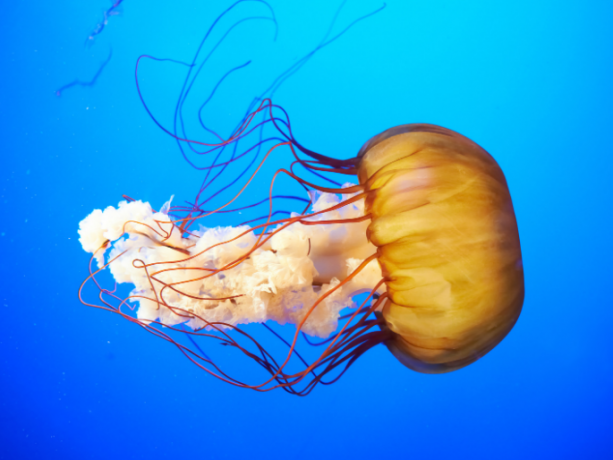The animal kingdom, also known as animalia kingdom or Metazoa, is the large group of living beings formed by heterotrophs by ingestion, that is, beings who do not produce their own food and need to eat it. This feature sets them apart from plants, which produce their own food through photosynthesis.
Some examples of animals that are present in the animal kingdom are birds, worms, sea sponges, insects, reptiles, humans and thousands of others.
Characteristics of the animal kingdom
- Diversity: there are several species of animals, different from each other, whether in body shape, reproduction or way of life;
- Classification: Animals vary in complexity and are classified based on anatomy, morphology, evolutionary history, and embryonic development;
- Most animals have mobility, that is, they move through at least some stages of their lives; and most animals reproduce sexually.
- The animals have real fabrics, that is, tissues formed by a set of cells that perform the same function. These tissues form, for example, the organs and systems of animals. They are: the ectoderm, the endoderm and the esoderm. Only porifers have no real tissue;
- have coelom, an important cavity in the process of embryonic development, in which it helps to form important parts of the body, such as the mouth and anus. It is important to remember that porifers do not have coelom and plathelminths have pseudocoelomas (false coelomas, which do not fulfill their function);
- are multicellular: are made up of more than one cell. Some members of other kingdoms are made up of only one cell, such as bacteria or amoebas;
- are heterotrophic: need to get their own food. Plants are autotrophic because they produce their own food through photosynthesis. Since they cannot produce their own food, members of the animal kingdom must ingest other organisms;
- are eukaryotes: this is the type of cell that animals have. Eukaryotic cells are more complex than prokaryotic cells because they have an individual nucleus, which holds all the animal's genetic material (the DNA);
- They do not have cell walls: Plants, fungi, and prokaryotic cells have a cell wall, a rigid outer layer that gives cells structure;
- reproduce in a way sexual. However, a few animals reproduce asexually.
See also the meaning of fauna and taxonomy.
phyla of the animal kingdom
The animal kingdom, meaning all animals, are divided into phyla, a system that classifies animals based on:
- your anatomy: structural organization of the body, including systems (example: respiratory, digestive, among others), organs and tissues;
- your morphology: the external structure of the body;
- your evolutionary history;
- its characteristics in the fetal develop: the formation of the animal;
All phyla are important to maintain the balance of the ecosystem and food chain in the animal kingdom.
In the animal kingdom there are about 36 phyla, however, only 9 encompass most animal species.
We list and explain below the 9 main phyla of the animal kingdom, according to their history and evolutionary order.
porifers
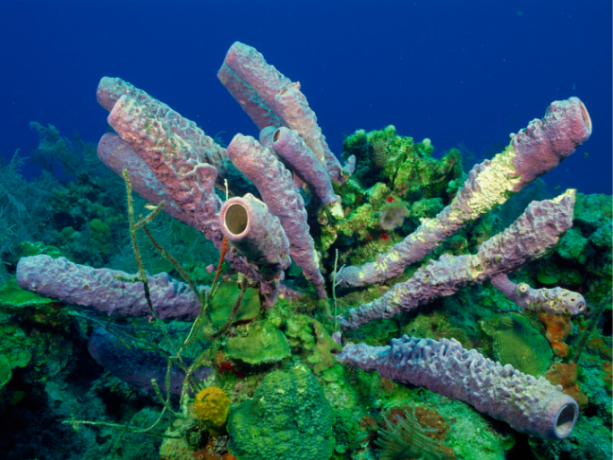
What are porifers?
These are multicellular animals, called sea sponges, considered the simplest and oldest phylum in the animal kingdom.
Its habitat is the oceans and its body is formed by pores (hence the name porifers), a kind of hole that helps in food intake and breathing.
With the help of these pores, sponges also act as a filter for the water in which they live.
Example of animal from the poriferous phylum: sea sponges.
Porifera characteristics:
- are invertebrates;
- have a rigid outer layer;
- no they have real tissue: the esoderm, endoderm and ectoderm;
- they do not have coelom (an important cavity for embryonic development).
Importance to the animal kingdom: are considered as “filters” of water. Through their existence, it is also possible to determine the quality of the water where they are inserted. Therefore, they can be classified as “bioindicators”.
They also serve as food for some turtles and shelter for some types of fish.
Cnidarians
What are cnidarians?
These are animals that live in both salt and fresh water, such as jellyfish and corals.
They are known to have a kind of “stinger”, where they release a toxin that serves both to capture prey for food and as a defense mechanism against predators.
A differential of this phylum is its shape, which can be free, like living water, or fixed, like corals.
Some examples of animals of the cnidarian phylumAttractions: corals, jellyfish and sea anemones.
Characteristics of cnidarians:
- have a toxin that is used to capture prey and as a defense mechanism against predators;
- the two basic forms of the body of the cnidarians are the jellyfish (free form), like living water, and the polyp (fixed form), like the corals;
- are invertebrates;
- they are the first phylum that has two types of real tissues produced during their formation: the ectoderm and the endoderm.
Importance to the animal kingdom: in corals, for example, most of the diversity of marine life lives. They serve as a shelter for some species of fish and also associate with a type of alga to feed on them.
These same algae also serve as food for some species of fish.
See also the meaning of biodiversity.
platyhelminths

What are flatworms?
They are invertebrate and soft-bodied worms, known mainly for having a flat body.
In fact, a flatworm's body shape is flattened to aid its breathing and digestive process, as this phylum lacks these two complete systems.
Flatworms are known to cause serious illnesses to humans and other animals. Schistosomiasis, for example, is one of the main diseases caused by these worms.
Some examples of animals from the flatworm phylum: planarian, louse, tapeworm.
Characteristics of flatworms:
- are invertebrates;
- are the flattened types of worms;
- it is the first phylum that has all three true tissues (the ectoderm, the endoderm and the esoderm), constituted during its formation;
- it is the first animal on the evolutionary scale to have a head.
Importance to the animal kingdom: some species can serve as bioindicators, indicating soil degradation.
Aschelminths
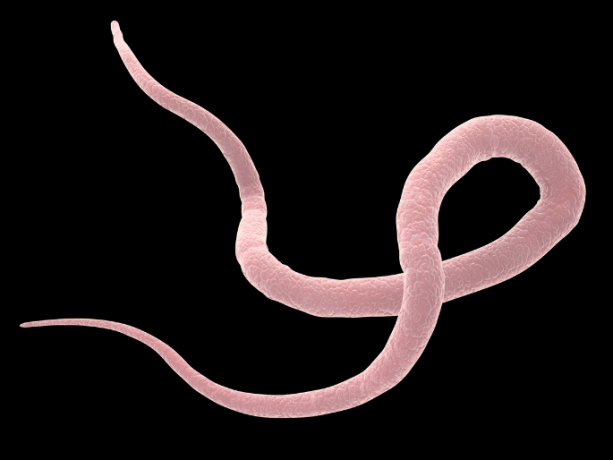
What are aschelminths?
They are another class of worms, which can be found in different habitats, both terrestrial and marine. They are known for their long, cylindrical shape.
In terrestrial environments they are mainly found as parasites of plants and animals.
Examples of animal of the phylum aschelminths: roundworm.
Characteristics of aschelminths:
- they have a complete digestive system, that is, they have a mouth and anus;
- are invertebrates;
- are the cylindrical and long worms;
- they may have a free life, but they are mostly parasites;
- they have the three true tissues, constituted in their formation (the ectoderm, the endoderm and the esoderm).
Importance to the animal kingdom: some species help to distribute nutrients in the soil and collect excreta.
molluscs

What are molluscs?
They are soft-bodied animals, some consisting of a shell, a kind of shell that protects the body, like oysters.
Molluscs form a very diverse group and constitute an important part of the ecosystem.
These animals can be seen in freshwater or saltwater habitats. They feed on small algae, particles of substances that are present in water, or even other small marine animals.
Some examples of animals from the mollusc phylum: slugs, snails, octopus, squid, oyster, mussel.
mollusc characteristics:
- they have cutaneous breathing, and skin that is very sensitive to dehydration, so they flee from the sun;
- they have the three true tissues, constituted in their formation (the ectoderm, the esoderm and the endoderm);
- are invertebrates;
- it is the second largest phylum in the animal kingdom.
Importance to the animal kingdom: oysters are great bioindicators in this group, as their life can indicate the quality of the water in which they are inserted. In addition, many of them serve as food for other animals.
annelids
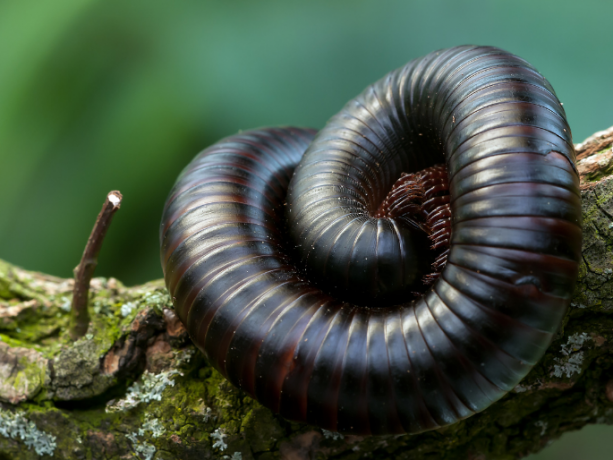
What are annelids?
These are the worms known for having a segmented body with a kind of ring (which gave rise to its name), such as the earthworm.
They have a big difference from the other phyla, because they can live in three types of habitat: wet land areas, fresh water and salt water.
Annelids are also known to vary widely in size, measuring from millimeters to 3 meters in length.
Some examples of animals of the annelid phylum: earthworms, leech, earthworm.
Characteristics of annelids:
- it is the first group in evolutionary order that has separation in the body through rings, which gives rise to its name;
- they have bristles that allow you to move around more easily in the environment;
- they can live in fresh water, salt water, moist soil or even parasitizing on other organisms;
- they have the three true tissues, constituted in their formation (the esoderm, the ectoderm and the endoderm).
Importance to the animal kingdom: Annelids are especially important for planting, as they feed on the remains of dead plants and animals, recycling organic matter.
arthropods
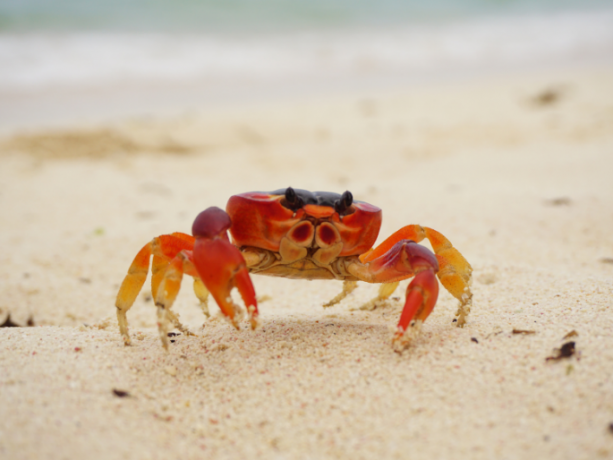
What are arthropods?
This is the largest phylum in the animal kingdom, with thousands of species. These animals are mainly known for having articulated paws, which help in fast locomotion and in their adaptation to the environment.
Some of the best known animals in this phylum are spiders, crabs, shrimp, centipedes, ants, bees, among others.
A great feature of this phylum is the presence of an exoskeleton, a form of shell that protects the body and organs of these animals.
Some examples of animals from the arthropod phylum: insects, crustaceans, arachnids.
Arthropod characteristics:
- it is the largest phylum in the animal kingdom;
- they have the three true tissues, constituted in their formation (the ectoderm, the esoderm and the endoderm);
- they have articulated legs, which allow for better movement of the animal and its adaptation to the environment;
- they are formed by a chitin exoskeleton, a type of bark that provides greater protection to these animals and supports the musculature;
- possess the complete digestive system.
Importance to the animal kingdom: they serve as food for other animals and are important in the life cycle of some types of vegetables.
echinoderms

What are echinoderms?
Echinoderms are marine animals, that is, they live only in salt water. They are mainly known for the presence of thorns on their bodies, such as the starfish.
They are animals that feed on algae or even other small animals in the marine environment.
Another great feature of this phylum is its regeneration capacity. For example, if you cut a starfish in half, it will be ruled by two others.
Some examples of animals from the echinoderm phylum: starfish, sea cucumber, sea urchins.
Characteristics of echinoderms:
- presence of thorns on the body.
- they have the three true tissues, constituted in their formation (the esoderm, the endoderm and the ectoderm);
- are exclusively marine;
- feed on algae or other small animals;
- they have an ambulance system, a set of bags that water inside them that allow their locomotion through the water;
- they are formed by limestone endoskeleton (provided by the endoderm), which allows their shape with thorns.
Importance to the animal kingdom: can produce oxygen for the water where they live and also feed on some algae, controlling their growth.
Strings

What are strings?
It is probably one of the best known phyla in the animal kingdom. Within the phylum of the chordates, there are well-known animals, such as birds, amphibians, mammals, among others. We humans are included in this phylum.
What differentiates this phylum from others is the presence of cartilage, which helps in the structure of the central nervous system, in addition to the circulatory and digestive systems being complete.
Some examples of chords: fish, reptiles, amphibians, birds and mammals.
Characteristics of the chords:
- they can be vertebrates or invertebrates;
- they are considered the last within the evolutionary scale of the animal kingdom;
- are adapted to survive in different types of environment;
- they have the three true tissues, constituted in their formation;
- humans are included in this phylum;
Importance to the animal kingdom: are at the top of the food chain, which helps to balance the ecosystem.
Difference between the animal and plant kingdoms
What differentiates the animal kingdom from the vegetable is mainly your way of eating. Vegetables produce their own food through photosynthesis, while animals need ready-to-eat food.
However, even producing their own food through photosynthesis, plants need animals for their survival.
Many animals are responsible for producing nutrients for the soil, which helps the plant kingdom survive, for example.
There is also the exchange of gases. By inhaling oxygen, animals release carbon dioxide, which together with mineral salts and soil water, helps in the chemical reactions of the plant, necessary for its development.
See also the meaning of:
- Plankton;
- homo sapiens;
- Environment;
- Physiology;
- eukaryotic cell;

